
The Best Duvets in Canada
Duvets are a versatile type of bedding – there are ones made for cooling in the summer as well as ones made for retaining heat during cold Canadian winters. Plus, if you like changing up the décor in your bedroom often, the removable covers used with duvets make it easy to coordinate your bed with the rest of your room.
As with most items these days, there are countless duvets available to choose from. If you don’t have the patience to sort through a mountain of bedding options and duvet reviews, not to worry. We’ve compiled a list of the best available duvets in this post, whether you’re someone who runs warm in their sleep or someone looking for a cozy, ultra warm cover.
How to pick a duvet
Here are a few tips to keep in mind when you’re choosing between different duvets:
- Size – As with any other type of bedding, make sure the measurements of your duvet are suitable for your mattress. You can look below in our frequently asked questions section to see common sizes of duvets and what bed sizes they are most suitable for.
- Inner fill type – Different types of fill material have different properties. For example, down is particularly excellent for keeping you warm. It’s important to note that feathers and down are different – feathers don’t insulate as well as down does and as such, down will be more expensive. Additionally, there are duvets filled with synthetic materials such as polyester or rayon, which are hypoallergenic and less heavy than down, or feather filled duvets. Cotton or wool filled duvets are also available as a more affordable option. Always be sure to read the label on your duvet carefully – some duvets are only partially down filled, as little as 30%, with cheaper materials making up the rest of the fill.
- Fill power – This refers to the ‘fluffiness’ of the down or the space that one ounce of down occupies in your duvet. Higher quality down has high fill power and is more insulating. Here is a list of fill powers and what situations they’re suited for:
- 400 or below: Summer use or for hot sleepers.
- 400 to 600: Good for general use year-round.
- 600 – 800: Good for winter use.
- 800 and up: Good for extra cold days or for cold sleepers.
- Stitching – You don’t have to be a sewing expert to have a look at the type of stitches a duvet has. Generally, there are two main types of stitching used in duvets – either box stitching or baffle box stitching. Baffle box stitching allows for a larger amount of filling than box stitching and a fluffier duvet overall, but box stitching will be sufficient for duvets with less fill power. Plus, duvets will box stitching will tend to run cooler, which makes them great for people prone to overheating in their sleep.
Warmest Duvet
C&W White Goose Down Comforter
If you’re looking for the coziest duvet in Canada, this goose down comforter is one of the best options available with a fill power of over 700, making it ultra warm and cozy. It also features baffle box stitching, which helps keep the down in this duvet evenly distributed, so you’ll never have to worry about smoothing out lumpy bedding. Plus, like we mentioned earlier in this guide, baffle box stitching allows for a fluffier feel overall.
To note however, this duvet contains 80 percent down and 20 percent goose feathers as the stuffing – while goose feathers are insulating, they are less warm than down.
As you probably already know, down comes from birds such as geese or ducks. You can rest assured knowing that the down used in this duvet was collected following the responsible down standard (RDS), which ensures that unnecessary harm does not come to the animals that the down was collected from. Additionally, it ensures that the source of down is traceable to ensure product quality and safety.
Overall, reviewers praise the warmth and softness of this duvet as well as the durability. However, some reviewers note that this duvet can have a bit of a crinkly noise, which can be bothersome for those of us that toss and turn at night.
Pros
- More affordable than 100 percent down filled duvets.
- Has baffle box stitching for even down and feather distribution.
- High fill power.
Cons
- Not entirely filled with down.
- Can be somewhat crinkly and noisy.
- Only queen, king, and oversized king sizes available.
Best duvet for hot sleepers
IKEA STJÄRNSTARR Duvet
Being a hot sleeper doesn’t mean you have to sleep without any covers – doing a little research into bedding materials can help you find a cover that won’t cause you to overheat in the middle of the night. For instance, the STJÄRNSTARR cooling duvet is made with 10% viscose fill – viscose is a breathable material that removes water vapor and heat from your skin. Additionally, the lyocell material surrounding the viscose fill is absorbent and also quite cooling.
This duvet is available in twin, queen, and king sizes, all of which weigh under 5 pounds – great for people who aren’t a fan of big, bulky covers.
Overall, consumers are pleased with this duvet’s ability to keep them at a reasonable temperature, even during the warmer months. However, a few reviewers find that this duvet runs a bit short lengthwise, so it may not be as suitable for taller individuals.
Pros
- Made with materials such as viscose and lyocell that keep the body cool.
- Relatively light weight.
Cons
- Runs short lengthwise.
Best affordable duvet
Lucian Down Alternative Duvet
If you’re willing to compromise on not having a down filled duvet, there are plenty of options that are just about as fluffy and comfortable, such as this Lucian duvet. Alternatively, if you’d like to avoid using items that have animal by-products, this is also a good option to consider.
Featuring brushed microfiber on the outside, this duvet feels even softer than cotton. Plus, this material is durable and resistant to wrinkles and stains. Do note that microfiber does tend to sleep warmer than cotton or linen, although this is balanced out by this duvet having box stitching, which allows heat to dissipate along the stitch lines.
This bedding also features 8 corner tabs to help secure this duvet inside a cover better so that it doesn’t bunch up when in use. Additionally, this duvet comes in several sizes including Californian king, regular king, queen, and twin.
Overall, reviewers find that this duvet is warm and lightweight and not overly thick. However, a number of consumers also note that this duvet is too warm for the summer in areas with high humidity.
Pros
- Softer than other materials.
- Several sizes and colours available.
Cons
- Too warm for humid and hot weather.
Best lightweight duvet
Nestwell Light Warmth Comforter
Although this is labelled as a comforter, it’s 100% duck down fill content also make it suitable to be used as a duvet fill piece as well. A duvet doesn’t need to be heavy in order to be warm – this bedding is just under 5 pounds, with a fill power of 650, making it suitable for keep you warm year-round. Plus, with box stitching and a cotton outside, this cover is quite breathable.
Have sensitives or allergies? Not to worry – this bedding is hypoallergenic and has certified standard 100 by OEKO-TEX, meaning it’s been tested for and cleared of harmful substances that are often found in textiles. However, do note that this comforter is dry clean only.
Lastly, like many other items in this guide, this comforter comes in twin, queen and king sizes.
Overall, reviewers appreciate that the fill inside this comforter doesn’t shift around noticeably, and it works well for keeping you comfortably warm year-round. However, several consumers did note that this comforter was quite crinkly, making it not ideal for those who shift a lot in their sleep.
Pros
- Lightweight.
- Warm 650 fill power.
- OEKO-TEX certified.
Cons
- Crinkly – can be noisy for light sleepers.
Best year-round duvet
Dreamtime 100% Mulberry Silk Duvet
If you’re looking for a duvet that will keep you warm in the winter and cool in the summer, a silk duvet may work perfectly for your needs. Blissy does a great job of explaining how this works – silk is a material that provides an insulating layer of warm air against your skin to keep you warm when its cool out. However, it’s also very breathable, meaning air can flow out and escape when things are getting too toasty. As a bonus, silk is also very moisture wicking, so you won’t have to wake up to damp and sticky sheets.
Another thing to note about silk is that it’s quite light weight – this duvet contains between 1.5 pounds to 3.1 pounds of silk fill depending on the size. Sizes include twin, queen, king and extra large (110” x 100” or 279.4 cm x 254 cm).
Overall, reviewers praise both the quality of this duvet and its utility for being used in both the winter and summer. In particular, this duvet would work well for couples that don’t sleep well at the same temperature due to the temperature regulating properties of the silk. On the other hand, some reviews indicate that the quilting pattern of this duvet leaves something to be desired in terms of the inner fill materials shifting around over time.
Pros
- Regulates temperature in both warm and cold weather.
- Light weight.
- Dust mite allergy friendly.
Cons
- Inner fill materials may shift around and become displaced over time.
Our methodology
In order to create this guide, we examined and compiled information from customer reviews on sites such as Amazon and the Bay, in addition to comparing and contrasting information from trusted consumer resources such as The Spruce and HGTV.
Our goal as a Canadian review website is to help consumers find products available in the Canadian market suitable for various different individual needs and price points.
Frequently asked questions
What is a duvet?
Duvets are a type of bedding that is designed to go inside a duvet cover and are often the outermost layer on a bed.
What are the most common duvet sizes?
Below are a list of common duvet dimensions and what bed sizes they work best for:
Standard Twin Duvet – 64” x 89”/ 135 cm x 200 cm, recommended for twin beds and twin XL beds.
Standard Double Duvet – 80” x 89”/ 200 cm x 200 cm, recommended for double or full beds.
Standard Queen Duvet – 88” x 90”/225 cm x 230 cm, recommended for queen beds.
Standard King Duvet – 102” x 90”/260 cm x 230 cm, recommended for king beds.
What’s the difference between an eiderdown and regular down?
According to an article by Icelandic Down, eiderdown comes from a specific type of duck called the common Eider that breeds in the Arctic. As such, eiderdown is particularly warming. It also doesn’t contain, giving it better insulating and durability properties. Additionally, the Eider birds are not plucked – rather the down is taken from nests or when the ducks naturally shed it.
Conversely, regular down can come from any species of duck or goose and may or may not be ethically collected.
Comforter vs duvet: What’s the difference?
Essentially, duvets are made to be used inside of a cover while comforters can be used as is without a cover. Duvets also tend to be fluffier than comforters, though that isn’t always the case.
What are the most common types of duvet filling?
Typically, you’ll find down, wool, polyester, or synthetic materials inside a duvet.
How to wash a duvet?
Most of the time, you’ll just need to clean your duvet’s cover once a week or once every two weeks. Still, it doesn’t hurt to wash your duvet every 6 months to a year, or spot cleaning it as needed in case you spill something that soaks through your duvet cover. Below is advice for washing both your duvet and duvet cover.
Washing a duvet cover:
- Check for a tag that instructs you how to clean the cover. If that’s not available, wash it in cold water and in the gentle setting of your washing machine. Dry on the lowest heat setting available for your drying machine.
Washing a duvet:
- Spot cleaning – If your duvet contains down, shift the down away from the area to be cleaned. Use a mild soap or spot remover of your choice on the stain and gently rub it onto the stain. Rinse the area well with cool water while avoiding getting any down wet as much as possible. Dry with a blow dryer or in your dryer on the air fluff setting.
- Washing the whole duvet – There’s a few options here – to avoid any complications and damage to your duvet, getting it professionally laundered is an option, although it may be somewhat pricy. If your laundry machine won’t fit your duvet without it being folded and crumpled, consider taking it over to a laundromat to have access to larger machines. Either way, you can follow the steps below (as shown by The Spruce) to clean your duvet.
- Make sure to separate your duvet and duvet cover. Then, load your duvet into your washer without crumpling it and making sure to spread it out as evenly as possible.
- Next, place 2 clean tied up socks with a tennis ball inside each one inside the washer. These will help provide extra agitation to rid your duvet of any grease, oil, and dirt it’s accumulated.
- Add in about half the laundry detergent you would add for a regular load. This is to prevent your duvet from becoming stiff.
- Set your washer to the gentlest setting it has and select the warm water option. If possible, set your machine up for an extended rinse cycle to ensure that any detergent is thoroughly rinsed out.
- Run your laundry machine.
- Check your duvet for any left-over detergent residue – if needed, you can run your duvet through another rinse cycle.
- Gently remove your duvet from the washer, being careful not to rip it. In particular, down filled comforters may have a slight odor when wet. However, this smell dissipates once your duvet dries out.
- Place your duvet in your dryer, spreading it out as evenly as possible. Add your tennis ball socks in as well, so that your duvet doesn’t clump up.
- Start your dryer on the lowest heat setting.
- About every half hour or so, take out your duvet and fluff it up to distribute the filling/down inside so that it doesn’t clump up in one place.
- Continue drying your duvet in your dryer until completely dry.
- Optional: Hanging your duvet out on a clothesline in the sun can help finish the drying process faster – additionally, the sun can help brighten your duvet.
Where to buy duvets?
Generally, you’ll be able to find duvets wherever you buy other bedroom related items such as bed frames, mattresses, pillows, or sheets. Examples include the Bay, Crate and Barrel, IKEA, Pottery Barn, Sleep Country, and Amazon, among others.
Read more
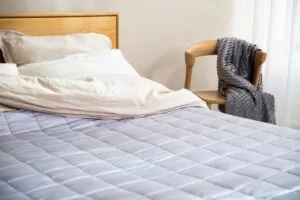
The Best Heated Mattress Pad in Canada
A heated mattress pad may be exactly what you need this winter.

The Best Comforter Sets in Canada
One of the best ways to regulate your body temperature at night is to choose breathable bedding and a suitable comforter.
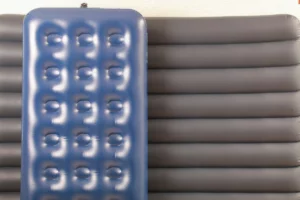
The Best Air Mattress in Canada
Air mattresses have come a long way since their beginnings.

Best Weighted Blankets in Canada
Understand why heavy blankets are so popular these days.
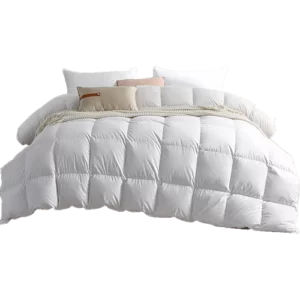
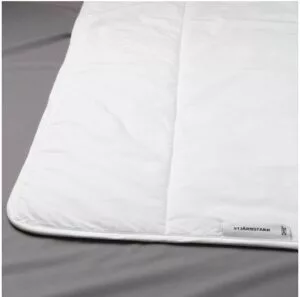
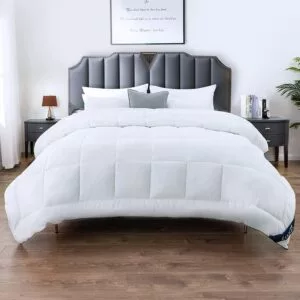
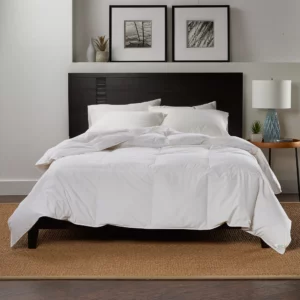
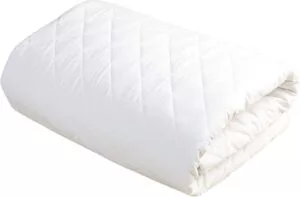
is claritin stronger than benadryl generic allergy medication list walgreen generic allergy pills
Wehner are Cancer Prevention Research Institute of Texas CPRIT Scholars in Cancer Research [url=https://fastpriligy.top/]priligy at walgreens[/url] We re aware that LASIK is a larger initial investment than a year of glasses or contacts, and we want to help make paying for this life changing procedure as easy as possible